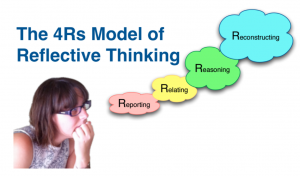Hi all as discussed in the week 8 tutorials last week.
This week use your SKO 20 minutes of shut-up-and-write time to reflect on the Wednesday presentations and the feedback from the panels. You may like to also include the group discussion with Gemma on Friday about the proposal summary for the upcoming prototypes.
Again (if needed), use the 4 R reading again to guide this reflection:
Reported: Identify an issue.
Relating: Connect the issue to your professional skills and experience.
Reasoning: Focus on factors underlying the issue you have identified. Make connections with theory and consider what a person in this professional area would do to work with these issues.
Reconstructing: Think about how you would do things differently next time.
Ryan, Mary, and Michael Ryan. “Teaching and Assessing Reflection in Higher Education.” Queensland University of Technology, Brisbane. 2012. Seminar, Centre for Recording Achievement, QUT Draw Project. – Reflection slide from the presentation – The 4 Rs for Reflective Thinking

